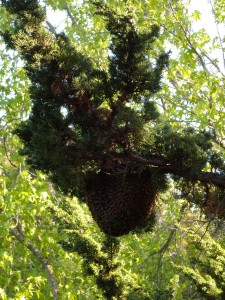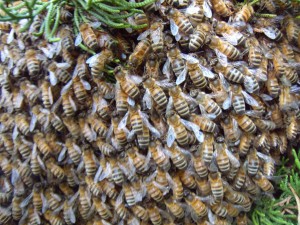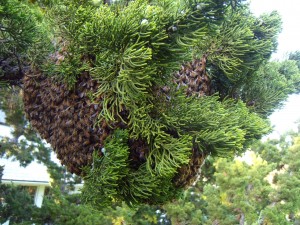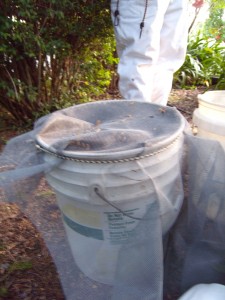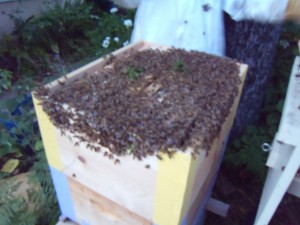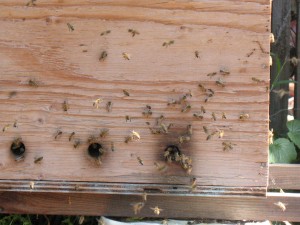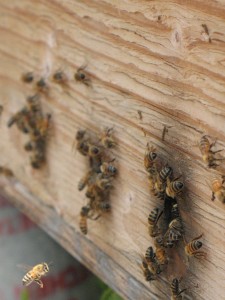Despite my best intentions, life has prevented me from writing a follow up about our first hive split until now. There’s been plenty of drama and uncertainty along the way, but a recap of the timeline of events will have to suffice. Be warned: the following is kind of geeky and detailed.
March 26th: a mating flight?
The host of our first split emailed to let us know that the original hive has seen a huge decrease in activity and that only an occasional bee exits or returns to the split.
I dropped by after work to take a look, wondering if the main hive swarmed (it did, after all, have oodles of queen cells leftover after splitting). It was around 5:30 when I arrived, and the afternoon was cooling off. There seemed to me to be a perfectly respectable stream of bees coming and going at the main hive’s entrance.
As luck would have it, the hosts were home and came rushing out to tell me the latest news. They reported that both the hive and the split had been extremely active through the afternoon and that they had been particularly impressed by the large number of bees flying around the front of the split.
Kelly tells me that, according to The Buzz About Bees, workers often engage in mass orientation flights when a virgin queen goes out to mate. Could it be that this was that most auspicious day?
April 1st: another swarm?
Our helpful hive hosts called around 2:00 to report that hundreds (thousands?!) of bees were hanging off the front of the original hive. Kelly packed up equipment and sped to the site, only to find that the bees seemed back to normal. The question remains whether the swarm took off into the neighborhood before she arrived, or changed course and went back into the hive. We have witnessed this change of plans with other colonies. Unfortunately, the hosts hadn’t stuck around to watch after their phone call, so there’s no way to know for sure.
April 3rd: a tiny swarm or a botched mating flight?
We received another call from our unflappable hive hosts. They reported that another group of bees, smaller this time, was hanging off the front of the original hive. When next they ventured to the window, our hosts found that the group was now milling about on one of the hive stand boards and that there were significantly more bees than usual on the ground beneath the hive.
An hour later, when I got the message and called them back, the bees had once again dispersed. Whether they returned to the hive, or took off, was again uncertain. The host estimated that the group of bees had been about the size of a baseball. Tiny.
The small size of the cluster and the large number of bees on the ground made us wonder if this was a botched mating flight for a virgin queen with bad wings. We began to fear that our clumsy handling of the capped queen cells present in the hive when we split it might have led to unborn queens falling on their heads and developing improperly. No joke. Queen bee pupae are susceptible to this type of injury for the first two days after the queen cells are capped.
April 13th: exploratory inspection yields no brood
Plagued with concern, we decided to inspect both hives to look for queens and brood.
The original hive has four boxes. When we split this hive on March 17th, the brood nest was in the middle two boxes, and the bottom box was mostly empty. We added the fourth box that day to allow room for the bees to cure nectar, should they so desire.
For this first post-split inspection, Kelly and I went through the top two boxes and found that the bees were busy curing nectar. We found no brood and no queen. We judged the bees to be slightly “edgy.” We also found two supersedure cells on a frame in the second box from the top, but the bees seemed to be ignoring them, leading us to surmise that the cells were not viable.
We saw no pollen coming in on foragers’ legs.
By contrast, the new little split was teeming with purposeful seeming bees. We saw many bees bringing in pollen. The hive’s queen cells had hatched, but for the life of us we couldn’t spot the queen. As we inspected, bees began fanning at the entrance of the hive. Although I would have interpreted this as communication about the whereabouts of the (invisible) queen bee, subsequent correspondence with Serge Labesque (check out the online version of his column in The Monthly Extractor) now leads us to believe this behavior is cause for concern in a new split. Hmmm…
We found no brood in the little split, but we judged the bees to be less edgy, and we were heartened by their foraging and nectar curing.
April 19th: thorough inspections still leave unanswered questions
I returned this past Friday with the intention of finding evidence of a laying queen in the original hive, or recombining the hives. I went straight to the middle frames of the top two boxes on the original hive, again finding only curing honey.
In the second box from the bottom, I found the queen on the first frame I pulled. No one seemed to be paying much attention to her, and I resolved to watch her until she laid an egg. This took a while. Eventually, she dipped her tail into a cell and then moved on. I squinted with all my might, but couldn’t see an egg. Then I watched her stick her tail deep into a cell. She took her time with this one, and the surrounding bees seemed to perk up and pay attention. Unfortunately, again, I was not able to see an egg.
A beekeeping acquaintance told me recently that you can tell how old an egg is by its angle in the cell; a newly laid egg stands up straight, while a one or two day old egg begins to tilt, until it is lying down on the bottom of the cell. If this is true, maybe I couldn’t see the eggs because of their angle?
I returned the frame with the queen and looked at the next one over. And there, joy of great joys, I found a full frame of the cutest little larvae I’ve ever seen in the daintiest worker bee comb (no drone layer here, thanks very much).
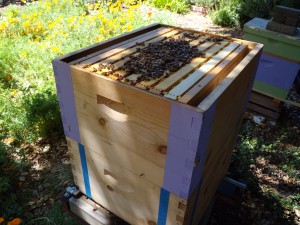
On top of the brood nest.
The bees also seemed less edgy to me, for what it’s worth, and the workers were bringing in plenty of pollen.
Unfortunately, the small split seemed very much the same as the week before. The bees are bringing in pollen, and they’ve arranged tidy arches of bee bread under the capped honey at the top of each frame. They fanned with gusto at the entrance and on some of the frames as I inspected, but I could not find any sign of the queen.
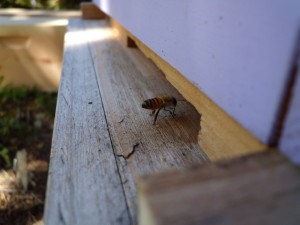
The last remaining fanner after the inspection.
We will return this weekend to inspect a final time before deciding whether to provide this small group with eggs to raise another queen.


